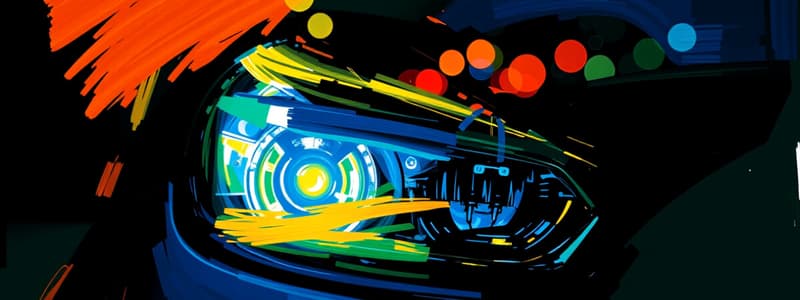Podcast
Questions and Answers
How is your vision different at night? (Select all that apply)
How is your vision different at night? (Select all that apply)
- The sharpness of images in front of you increases.
- Visibility to the left and right sides becomes clearer.
- Your eyes struggle adjusting from light to dark/dark to light. (correct)
- All of the above.
What are some ways the exact same road may look completely different from day to night? (Select all that apply)
What are some ways the exact same road may look completely different from day to night? (Select all that apply)
- Your headlights can illuminate over hills.
- Your headlights can't bend around curves. (correct)
- Animals are generally sleeping so you see significantly less of them.
- Pedestrians and bicyclists are more visible because they typically wear hi-vis clothing.
What are some behaviors that may indicate an impaired driver? (Select all that apply)
What are some behaviors that may indicate an impaired driver? (Select all that apply)
- A car brakes hard to avoid hitting a deer crossing the road.
- An SUV weaves from lane to lane without using turning signals. (correct)
- A truck swerves suddenly to avoid an unmarked pothole.
- All of the above.
How does a dirty windshield affect driving at night? (Select all that apply)
How does a dirty windshield affect driving at night? (Select all that apply)
Your low beam headlights enable you to see _____ feet ahead and high beam headlights about _____ feet ahead at night.
Your low beam headlights enable you to see _____ feet ahead and high beam headlights about _____ feet ahead at night.
Visibility at night is limited. What action(s) can you take to ensure you are able to see as well as possible? (Select all that apply)
Visibility at night is limited. What action(s) can you take to ensure you are able to see as well as possible? (Select all that apply)
When an oncoming vehicle has their high beam headlights on at night, you should:
When an oncoming vehicle has their high beam headlights on at night, you should:
To ensure other drivers see you and your truck at night:
To ensure other drivers see you and your truck at night:
At night, how should you adjust your following distance?
At night, how should you adjust your following distance?
To help avoid fatigue while driving at night, you should:
To help avoid fatigue while driving at night, you should:
Flashcards are hidden until you start studying
Study Notes
Vision and Night Driving
- Nighttime vision differs significantly; eyes struggle with light adaptation between dark and light environments.
- Roads can appear different at night; headlights do not bend around curves, limiting visibility.
- Animals are usually less visible at night as they tend to be inactive or sleeping.
Impaired Driving Indicators
- Drivers exhibiting impaired behavior may weave between lanes without signaling, indicating a lack of control.
Effects of Windshield Condition
- A dirty windshield can enhance glare from oncoming vehicle lights, impairing visibility while driving at night.
Headlight Range
- Low beam headlights illuminate approximately 250 feet ahead, while high beams can extend visibility to about 350-500 feet.
Nighttime Visibility Enhancement
- Actions to improve night visibility include dimming instrument panel brightness, ensuring lights and reflectors are clean, and keeping dome lights off while driving.
Dealing with Oncoming High Beams
- When faced with oncoming high beams, focus on the white line to the right to maintain lane control and minimize glare.
Communicating Intentions to Other Drivers
- To enhance visibility for others, consistently use turn signals during lane changes and turns to clearly communicate driving intentions.
Following Distance Adjustments
- Increase following distance by at least one second while driving at night to enhance safety and reaction time.
Preventing Fatigue During Night Driving
- To combat fatigue, schedule regular stops to rest or stretch during nighttime driving sessions.
Studying That Suits You
Use AI to generate personalized quizzes and flashcards to suit your learning preferences.




